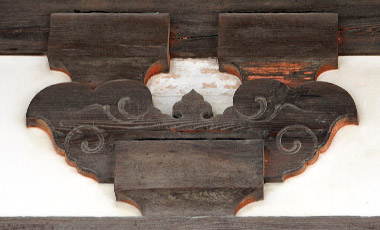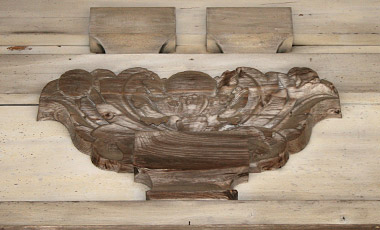|
||
 |
||

Houryuuji
Nandaimon 法隆寺南大門 (Nara)

Enjouji
Roumon 円成寺楼門 (Nara)
(C)2001 Japanese Architecture and Art Net Users System. No reproduction or republication without written permission.
掲載のテキスト・写真・イラストなど、全てのコンテンツの無断複製・転載を禁じます。
|
||||||
| hanahijiki 花肘木 | ||||||
| KEY WORD : architecture / general terms | ||||||
| Lit.
flower bracket arm. A decorative bracket arm *hijiki
肘木 that appeared in the latter part of the Kamakura period.
It evolved from the use of a bracket arm topped by twin bearing blocks narabito
双斗 (see *futatsudo
tokyou 二斗斗きょう), an architectural elements introduced with the daibutsu
style *daibutsuyou
大仏様 in the early Kamakura period. It is thought that the decorative ends
of the hanahijiki are derived from the placement of two daibutsu
style nosings *kibana
木鼻, back to back. The moldings, incised with numerous patterns and shapes,
have subtle variations from building to building. Like bearing-block capped
struts *kentozuka
間斗束 and frog-leg struts *kaerumata
蟇股, hanahijiki are placed at intervals *nakazonae
中備 between the bracket complexes *tokyou
斗きょう positioned atop the pillars *hashira
柱. There are some hanahijiki that have two bearing blocks placed
on each nosing to carry a bracket tie beam *tooshihijiki
通し肘木. Others support the bracket tie beam directly. A very rare arrangement
has the twin bearing blocks carrying a hanahijiki that supports two
more bearing blocks into which the bracket tie beam is set. Eventually,
the hanahijiki was extended in length so that it could carry three
bearing blocks and be used as a 3-on-1 bracket complex *mitsudo
tokyou 三斗斗きょう. |
||||||
 Houryuuji
Nandaimon 法隆寺南大門 (Nara)
 Enjouji
Roumon 円成寺楼門 (Nara)
|
||||||
| REFERENCES: | ||||||
| EXTERNAL LINKS: | ||||||
| NOTES: | ||||||
(C)2001 Japanese Architecture and Art Net Users System. No reproduction or republication without written permission. 掲載のテキスト・写真・イラストなど、全てのコンテンツの無断複製・転載を禁じます。 |
||||||